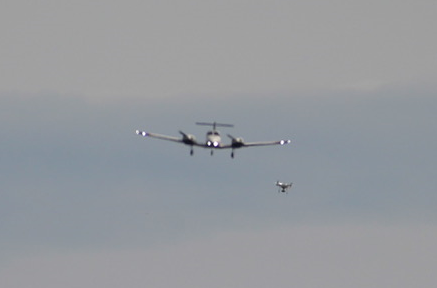An Embry Riddle study published in the SAE International Journal of Aerospace, entitled ‘Three Case Studies on Small Uncrewed Aerial Systems Near Midair Collisions with Aircraft: An Evidence-Based Approach for Using Objective Uncrewed Aerial Systems Detection Technology’, identifies and evaluates the extent of potential collision hazards between crewed and uncrewed aircraft currently taking place within US controlled airspace. It aims to inform the Federal Aviation Administration (FAA) about the effectiveness of existing regulations in preventing potentially hazardous encounter situations.
By 2025, the Federal Aviation Administration (FAA) predicts the Small uncrewed aircraft systems (sUAS) fleet to number nearly 2.4 million units. As sUAS operations expand within the National Airspace System (NAS), so too does the probability of near midair collisions (NMACs) between sUAS and aircraft. Currently, the primary means of recognizing sUAS NMACs rely on pilots to visually spot and evade conflicting sUAS. Pilots may report such encounters to the FAA as UAS Sighting Reports. Sighting reports are of limited value as they are highly subjective and dependent on the pilot to accurately estimate range and altitude information. Moreover, they do not account for NMACs that an aircrew member does not spot.
The purpose of this study was to examine objective sUAS and aircraft telemetry data collected using a DJI Aeroscope sensor and Automatic Dependent Surveillance-Broadcast (ADS-B)/Mode S messages throughout 36 months near a major United States (U.S.) airport. This data offers objective insights into the interaction of sUAS and aircraft in the airspace surrounding this airport. Using the data, three NMAC case studies are presented based on three varying mission profiles: (a) commercial air carriers, (b) general aviation (GA) aircraft, and (c) helicopters. The findings inform on sUAS-aircraft encounter evolution and trends, including areas of encounter risk, lateral and vertical encounter separation distances, sUAS operator compliance with operational and altitude restrictions, and comparisons of objective detection data against sUAS sighting reports.
Recommendations are provided to mitigate risks associated with encounter trends to further enhance safety within the NAS.
Read the free, full report, “Three Case Studies on Small Uncrewed Aerial Systems Near Midair Collisions with Aircraft: An Evidence-Based Approach for Using Objective Uncrewed Aerial Systems Detection Technology” by Ryan J. Wallace, Scott R. Winter, Stephen Rice, David C. Kovar, and Sang-A Lee, published in the SAE International Journal of Aerospace.




